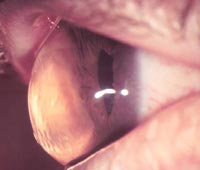Keratoconus is a progressive eye disease where the normally round cornea thins and begins to bulge into a cone-like shape. Keratoconus is difficult to detect, because it usually develops slowly but however, in some cases, keratoconus may proceed rapidly. "Kerato" is the word for cornea. Keratoconus (KC) is noninflammatory, bilateral ectatic corneal disease, characterized by paraxial stromal thinning and weakening which leads to corneal surface distortion.
This abnormal shape prevents the light which is entering the eye from being focused correctly on the retina and this causes distortion of vision. As keratoconus progresses, the cornea bulges more and vision may become more distorted. Keratoconus occurs in females slightly more compared to males.
The cause of Keratoconus is still unknown. The disorder progresses slowly and occurs in three forms:
keratoconus posticus circumscriptus,
autosomal dominant keratoconus
and autosomal recessive keratoconus.

In the early stages, eyeglasses or soft contact lenses can be used to correct the mild nearsightedness and astigmatism caused in the early stages of keratoconus. As the disorder progresses and the cornea continue to become thin and change its shape, rigid gas permeable contact lenses can be prescribed to correct vision adequately but however, in most people, the cornea will stabilize after a few years without ever causing severe vision problems. Genetic counseling may be of benefit for patients with an inherited form of keratoconus. Treatments for moderate and advanced keratoconus include:
Gas permeable contact lenses
"Piggybacking" contact lenses
ClearKone hybrid contact lenses
Scleral and semi-scleral lenses
Intacs or corneal inserts
Corneal cross-linking
Corneal transplant
About Eye
Eye Diseases
Vision problems
Find Cost
Surgeries & Treatments
Best Eye Hospitals
Testimonials
Get Free Quotes
Top Hospitals In India
Top Hospitals In Turkey
Top Hospitals In Mexico
Top Hospitals In Costa Rica
Top Hospitals In Singapore
Top Hospitals In UAE
Top Hospitals In Australia
Top Hospitals In Malaysia
Top Hospitals In Thailand
Top Hospitals In Phillipines